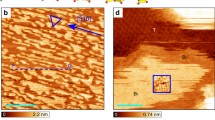Abstract
Micro-domains of modified surface potential (SP) were created on hydroxyapatite films by direct patterning by mid-energy focused electron beam, typically available as a microprobe of Scanning Electron Microscopes. The SP distribution of these patterns has been studied on sub-micrometer scale by the Kelvin Probe Force Microscopy method as well as lysozyme adsorption. Since the lysozyme is positively charged at physiological pH, it allows us to track positively and negatively charged areas of the SP patterns. Distribution of the adsorbed proteins over the domains was in good agreement with the observed SP patterns.



Similar content being viewed by others
References
Zhang PC, Keleshian AM, Sachs F. Voltage-induced membrane movement. Nature. 2001;413:428–31.
An YH, Friedman RJ. Concise review of mechanisms of bacterial adhesion to biomaterial surfaces. J Biomed Mater Res A. 1998;43:338–48.
Pashkuleva I, Marques AP, Vaz F, Reis RL. Surface modification of starch based biomaterials by oxygen plasma or UV-irradiation. J Mater Sci: Mater Med. 2010;21:21–32.
Kato R, Nakamura S, Katayama K, Yamashita K. Electrical polarization of plasma-sprayhydroxyapatite coatings for improvement of osteoconduction of implants. J Biomed Mater Res A. 2005;74A:652–8.
Cui FZ, Luo ZS. Biomaterials modification by ionbeam processing. Surf Coat Technol. 1999;112:278–85.
Aronov D, Rosen R, Ron EZ, Rosenman G. Electron-induced surface modification of hydroxyapatite-coated implant. Surf Coat Technol. 2008;202:2093–102.
Plecenik T, Tofail SAM, Gregor M, et al. Direct creation of microdomains with positive and negative surface potential on hydroxyapatite coatings. Appl Phys Lett. 2011;98:113701.
Lang, SB, Tofail SAM, Gandhi AA, et al. Pyroelectric, piezoelectric, and photoeffects in hydroxyapatite thin films on silicon. Appl Phys Lett. 2011;98:123703.
Arai T, Norde W. The behavior of some model proteins at solid–liquid interfaces 1. Adsorption from single protein solutions. Colloid Surface. 1990;51:1–15.
Xie Y, Zhou J, Jiang S. Parallel tempering Monte Carlo simulations of lysozyme orientation on charged surfaces. J Chem Phys. 2010;132:065101.
Pasche S, Vörös J, Griesser HJ, Spencer ND, Textor M. Effects of ionic strength and surface charge on protein adsorption at PEGylated surfaces. J Phys Chem B. 2005;109:17545–52.
Kandori K, Takaragi S-i, Murata K, Ishikawa T. Thermodynamic study of protein adsorption onto synthetic calcium hydroxyapatites. Adsorpt Sci Technol. 2005;23:791–800.
Kim DT, Blanch HW, Radke CJ. Direct imaging of lysozyme adsorption onto mica by atomic force microscopy. Langmuir. 2002;18:5841–50.
Barroug J, Lemaitre A, Rouxhet PG. Lysozyme on apatites: a model of protein adsorption controlled by electrostatic interactions. Colloid Surface. 1989;37:339–55.
Kandori K, Mukai M, Fujiwara A, Yasukawa A, Ishikawa T. Adsorption of bovine serum albumin and lysozyme on hydrophobic calcium hydroxyapatites. J Colloid Interf Sci. 1999;212:600–3.
Aronov D, Rosenman S. Direct low-energy electron beam nanolithography. Surf Sci. 2009;603:2430–3.
Acknowledgments
This project has been funded with support from the European Commission (EC NMP4-SL-2008-212533—BioElectricSurface). This publication reflects the views only of the authors, and the Commission cannot be held responsible for any use which may be made of the information contained therein. This work was also supported by the Slovak Research and Development Agency under the contract Nos. DO7RP-007-09 and APVV-0199-10, by the Ministry of Education of the Slovak Republic under Contract Nos VEGA 1/0162/10 and VEGA 1/0605/12 and is also the result of the project implementation: 2622020004 supported by the Research & Development Operational Programme funded by the ERDF.
Author information
Authors and Affiliations
Corresponding author
Rights and permissions
About this article
Cite this article
Plecenik, T., Robin, S., Gregor, M. et al. Directly created electrostatic micro-domains on hydroxyapatite: probing with a Kelvin Force probe and a protein. J Mater Sci: Mater Med 23, 47–50 (2012). https://doi.org/10.1007/s10856-011-4498-x
Received:
Accepted:
Published:
Issue Date:
DOI: https://doi.org/10.1007/s10856-011-4498-x




